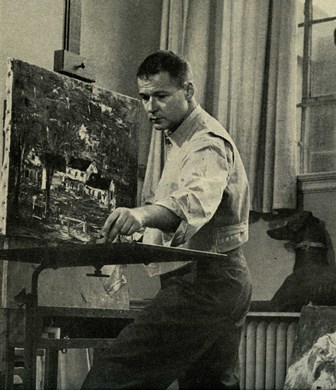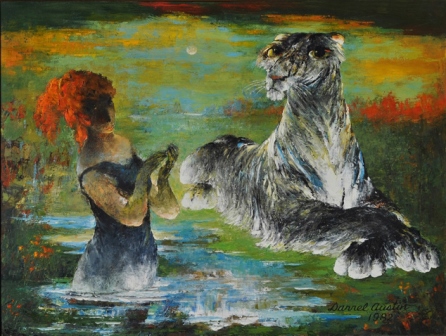|
The rich artistic history of Darrel Austin (American, 1907-94) is truly special as well as quite remarkable. Absolutely unique in style and subject matter, Austin stands alone in American art – never aligned with any "art movement". His fame is sandwiched between "American Regionalism" of the 1930s to World War II and "The New York School of Abstract Expressionism" starting in 1951, followed a decade later by “Pop Art” and “Op Art”. Among contemporary American artists Darrel Austin has often been thought of as a loner in the sense that his work is unlike any art movement either during his lifetime or since. Austin has created a unique world, separate, but similar to ours with its own particular landscape, its own sun and moon, its own beasts, and its own race of whimsical humanoid inhabitants. Many artists of the 1930s and 40s felt compelled to radically change their style after 1951, but Austin stayed the course.
"Darrel Austin's isolation helps explain why his paintings, once seen, stick in the memory with such unusual persistence. Who could forget an encounter, so unexpected, with one of his great cat-like creatures, or one of the phosphorescent bulls that inhabit his moonstruck woods and swamps?" (John Canaday "Darrel Austin: A Retrospective View", McNay Art Institute, 1982)
Born in southern Washington state, but essentially raised through high school in Portland, Oregon, Austin was a student and later assistant to the Flemish artist Emile Jacques who had immigrated to Oregon. He followed the artist to the University of Notre Dame but returned home when the artist died tragically swimming in Lake Michigan.
The W.P.A. offered a start when he won a commission to paint five paintings for the massive Timberline Lodge on Mt. Hood in 1935-6 which are still on display on the mezzanine level. The Portland Art Museum also purchased three of his oils and he won another commission to paint four 10’ by 8’ murals depicting the "The Triumph of Medical Education" for the Doernbecker Medical School (now a university) which were unfortunately destroyed during renovations in 1952.
Austin realized soon that he would never achieve fame and fortune by remaining in Oregon so he and his wife, Margot (a children’s book author and illustrator), moved to Los Angeles in 1936-7. He did exhibit a few of his paintings at a museum in San Francisco while passing through on the way south. By chance he was accepted into a distinguished art gallery in Los Angeles and had his first official solo exhibition at the contemporary Howard Putzel Gallery. The gallery was a favorite of the Hollywood crowd of movie producers, directors, and actors - exhibiting mostly European modern masters. Austin’s work was at a much lower price, so the show was very successful both in sales and art reviews. His style had changed slightly from the more rigid figurative work he had done in Oregon and took on a more European adaptation as well as slightly edgy expressionism.
It is impossible to assume what was transpiring in his mind but one might guess that he didn’t want to become a "society painter" for the Hollywood stars. He also knew that if he were to succeed in his wildest dreams that New York City was the only place to be in the future. A year later the Austins drove back to Portland and then east across the country. Not even an easy journey today with interstates and more reliable and faster cars. He also knew that he needed another change in subject matter and style.
When he arrived in New York he quickly befriended a few other artists and one recommended that he look into a new gallery which had just opened in 1938, the Perls Galleries. Klaus Perls had escaped Germany via Switzerland and brought with him European contemporary masters. Perls likely added Austin as an answer to reach the anti-European sentiment among art collectors who had been supporters of "American Regionalism", "Ash Can School" and "American Impressionism" art movements. Perls offered a show immediately to Austin in 1940, the first of many over the next three decades. The Archives of American Art in Washington, D.C. holds the entire Perls Galleries records. These records reveal Austin's sales from 1940 to 1948 represented 85% of their entire gallery sales. Of course, when Perls added Alexander Calder as their only other American artist, Austin had served his purpose. While their sales of Modigliani, Leger, Pascin, Vlaminck, Utrillo, Dufy, Dali, and others soon elevated Perls to one of the premiere art galleries in the country, they never forgot what Austin had done for them and supported him faithfully until they closed the gallery, knowing that our gallery in Naples was taking up the slack starting in 1964.
The Austins lived in Manhattan for a few years before deciding to move to New Fairfield, Connecticut north of Danbury. They bought a pre-Revolutionary house on a multi-acre plot of land with huge trees all around which would become one of his favorite subjects to paint, depicting ladies and beasts meandering under moonlit skies.
Darrel Austin used a palette knife to create his paintings building up layer upon layer of oil paint to the canvas. He would work on many paintings at the same time using a special self-designed rack system to keep each painting from touching any surface while they dried. He did not do "studies" beforehand, so the ink and pencil drawings are separate entities. He did pastels in 1943, 1956 and 1973, with 1956 being the year he painted exclusively in pastel. The drawings were mostly done in 1939-42, 1952 and 1973. Many drawings in 1973 were created with hard pressed conte crayon.
Commencing with the 1940 exhibition at Perls Galleries, Austin garnered almost immediate attention for his favorite themes of moonlit forests and nymphs in marshes. It is with that exhibition that his first beloved "Beast" with enlarged eyes was shown and sold to the owner of Gimbels Department store. Austin's beasts, which included jaguars, tigers, foxes, and lions became collectors' favorites throughout his painting career which ended by his choice in 1982.
Articles featuring Austin's paintings appeared throughout the 1940s in Art Digest, Art News, Life, Newsweek, Esquire, Cosmopolitan, House & Garden, Vogue, Time, and The New Yorker. Scores of art reviews were in newspapers nationally. It is easy to assume that the decade of the 1940s was Austin’s decade. Most of the museum purchases came during this time as well and he saw his work included at the Metropolitan Museum of Art, Museum of Modern Art, Detroit Institute of Arts, Boston Museum of Fine Arts, Smith College Museum of Art, Pennsylvania Academy of Fine Arts, and the Los Angeles County Museum of Art to name a few.
The door is certainly open for other museums in the future to include works from 1935 to 1982, which are available. Austin’s major retrospective was curated by Perls Galleries in 1982 at the McNay Art Institute in San Antonio, Texas and our gallery curated his memorial retrospective in 1997 at the Charles MacNider Museum of Art in Mason City, Iowa.
To experience Darrel Austin's world of fantasy is not easy to forget as his images are thought provoking, mysterious, beautiful, eerie, and compelling. It will be interesting to see how his efforts fit into the multitude of great artists over the centuries – likely, Austin will command his own distinct place in art history.
|


Rising Naiad by Darrel Austin,
Oil on canvas, 30"x40", 1982
|


